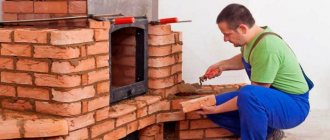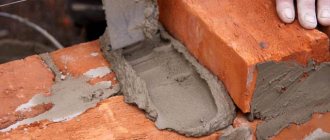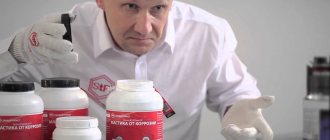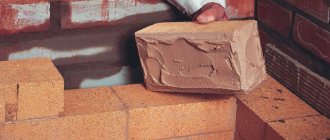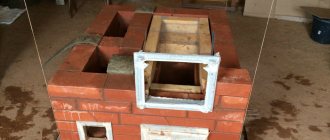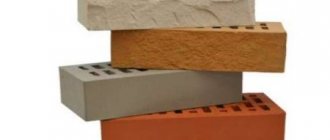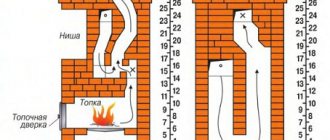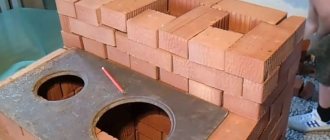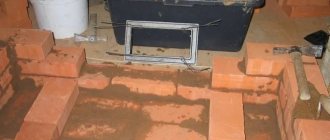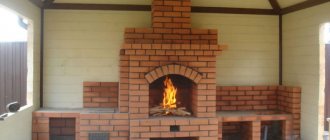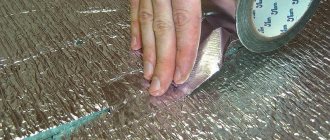Factory-made masonry mixtures for laying stoves
We are talking about fireproof dry powders, which, after dissolving in water, turn into a homogeneous mass. The cooking recipe is usually indicated in the accompanying instructions. Along with the usual components (sand and cement), the solution contains special heat-resistant additives.
The refractory mixture for laying furnaces produced at the enterprise has a number of advantages:
- Well-calibrated composition . Under production conditions, careful dosage of each component is carried out, according to time-tested recipes and proportions.
- Specific additives . The components that give refractory mixtures their “proprietary” characteristics are often not commercially available (and sometimes even kept secret).
- Versatility . As a rule, industrial solutions are multifunctional: they can be used to lay stoves and then plaster finished walls.
- External aesthetics . Although a finishing finish is still applied over masonry or plaster, it is much more pleasant to work with an attractive-looking mortar.
Our stove makers especially liked the products of such manufacturers of masonry mixtures for stoves and fireplaces: “PLITONIT”, “TERRACOT”, “Makarov Stove House”, “Pechnik”, “Scanex”, “SPO”. As for the disadvantages of this type of material, it is usually called their high cost. In cases where it is necessary to save money, they try to use self-prepared heat-resistant solutions.
A little personal experience
Friends, I have repeatedly worked with the construction of elements that were later used for heating with wood. Based on my experience, the biggest mistake that owners make is saving money. I was glad that they did not decide to save money on professionals, but I was very disappointed in the quality of the materials they purchased.
All work related to the construction of heat-resistant elements can be done with your own hands. It’s better to save your money and don’t overpay to expensive builders, but you can’t skimp on fireclay bricks and fireclay. No matter how cool the master is, he will not be able to make candy from underground raw materials. You can blame him later, but I am sure that you will be warned about this outcome of events.
Friends, remember my advice and save your savings by saving on the right things, and not on those that you vitally need! Warmth, comfort and speedy completion of the renovation!
Fireclay mixtures prepared at home
The main component of a self-prepared mortar can be cement, clay or lime. Its choice is directly influenced by the conditions of use and purpose of the stove or fireplace. Invariably, any homemade fireclay mixture for a stove contains sand and clay. To make it more plastic, milk of lime is added. Asbestos is usually used as reinforcement. In addition, other additives can be used.
When using refractory mixtures for laying home-made stoves, you should be prepared for certain disadvantages:
- Low strength . Clay is known for its poor resistance to mechanical stress. Therefore, solutions based on it are recommended to be used exclusively as masonry materials. For plaster, it is advisable to find a more durable composition. You also need to be prepared for the fact that the characteristics of clay may vary depending on its composition and location of extraction.
- Low attractiveness . It is advisable to finish stoves and fireplaces built in residential premises with factory-made solutions, because... homemade mixtures do not look aesthetically pleasing. They are allowed to be used in cases where the decorative effect of the finished surface does not play a special role.
conclusions
The solution for creating fire-resistant masonry is made from certain ingredients. Before work, it is important to check them for quality. This applies to clay and sand. Water should also be free of impurities. The sand must be sifted. As a result of high-quality preparation, durable and fire-resistant masonry can be created from the prepared mortar. Knowing the specifics of choosing materials and mixing the solution, preparing it yourself will not be difficult.
Recommended Posts
Japanese houses made of polystyrene foam
Cement mortar for bricklaying
Gypsum stone for interior decoration + photo
House made of expanded clay concrete blocks + reviews
Polymer concrete: composition, characteristics
How to nail the lining correctly + video
Features of working with ready-made heat-resistant mixtures
Having purchased a heat-resistant mixture for ovens, the first thing you need to do is carefully study the instructions for its use. As a rule, manufacturers recommend carrying out masonry and plastering work at a temperature of at least +5 degrees. To store the sealed substance, you need to choose a warm, dry room. Even in the store, the packaging is carefully inspected for damage that could cause a violation of the required proportions of the various components.
The most common proportion when preparing the finished solution is to dilute 1 kg of dry powder in 0.27 liters of clean water. If we are talking about masonry work, then before carrying out it, it is recommended to soak the bricks in water in advance: thanks to this simple procedure, it is possible to significantly increase the strength of the masonry.
Details on the topic
Cost of auxiliary and refractory raw materials
| Name | Manufacturing company | Packaging, kg | Packaging cost, rub | Cost 1 kg, rub |
| Fireclay clay | "VOLMA", Volgograd | 20 | 250 | 12 |
| Polyurethane Fireproof Foam | FOME Pro, Germany | Cylinder (690 ml) | 500 | — |
| Liquid glass No. 1 | "MITSAR", St. Petersburg | 15 | 420 | 28 |
| Liquid glass No. 2 | Bitumast, Belgorod | 12 | 740 | 60 |
| Base for mastic 3VMKV (industrial) | "Termostroy", Perm | 50 | 35 000 | 695 |
| Mertel | "TERRACOT", Kurgan | 20 | 360 | 18,5 |
Styling mixture
As mentioned above, raw clay can be used to lay refractory bricks, but for this the wall thickness must be at least one brick (i.e. 25 cm). With such masonry, stability will be weak, the wall will not crumble due to the static nature of the brick, and clay will help distribute the load. This is acceptable for fireplaces and stoves that are located inside the house, i.e. the seams will not shrink, and as a result, the walls will not be deformed.
Another problem with clay is that after some time it will spill out of the seam.
To make the masonry durable, we suggest using a clay-cement mortar. To prepare it, do everything according to the following proportions:
- Clay – 2 measures.
- Sand – 1 measure.
- Cement – 1/3 measure=10% of the total volume
So, the small amount of cement we add will help the clay stay in the joints. This solution is called heat-resistant, but only conditionally, since the composition still contains a flammable element. Such a solution of cement and clay can withstand temperatures of a maximum of +96 degrees.
Of course, the best solution to this problem would be to purchase ready-made fire-resistant masonry mortar. The latter is a refractory powder, which is used as a raw material to be added in proportions to the sand-cement mixture. The amount of powder added is calculated by temperature - the higher it is, the more powder we add. The thickness of the seam will be from 0.3 to 1.2 cm.
List of the best fire-resistant masonry mixtures
| Name | Manufacturing company | Packaging, kg | Packaging cost, rub | Cost 1 kg, rub |
| "OgneuporSnabService" | G. Novgorod | 25 | 200 | 8 |
| "TERRACOTTE" Masonry | G. Borovichi | 20 | 640 | 36 |
| "Hercules" | Yekaterinburg city | 20 | 270 | 14 |
| Termix | Novosibirsk city | 25 | 227 | 9,3 |
| BROZEX | G. Omsk | 18 | 220 | 13 |
Fireproof plaster
Mortars for plaster and masonry differ little in composition from each other, as do mixtures for general construction purposes. The difference between masonry mortar and plaster in functional terms is that the plaster layer plays a protective role and is able to withstand “impacts” from the external environment, which means its resistance is many times higher.
The simplest and most inexpensive way to impart fire-resistant properties to a plaster mixture is through the silicization procedure. In practice, this looks like adding silicon glue to the mixture, or as it is more simply called, liquid glass. To obtain properties that are sufficient for use for finishing the internal surfaces of a fireplace or stove, you will need to add 20% of the total volume of liquid glass to the mixture. For 1 m3 of solution you will need 200 liters of silicon glue.
Factory-produced refractory putties and plasters are made based on kaolin clay, a binder and fireclay dust (a waste product from the production of fireclay products). This mixture can withstand up to +210 degrees.
The best fireproof plasters produced at the factory
| Name | Manufacturing company | Packaging, kg | Packaging cost, rub | Cost 1 kg, rub |
| "Pechnik" | G. Perm | 20 | 380 | 19 |
| "PLITONIT-SuperFireplace" | Kirovsk LO | 20 | 860 | 43 |
| "Stroyzashchita" "Nertex-U" | Moscow | 15 | 276 | 18 |
| "Ekabud" | Saint Petersburg | 25 | 430 | 7,5 |
| "Dune" SHT-60 | G. Chelyabinsk | 25 | 230 | 9 |
| Bergauf Bautermo | Yekaterinburg city | 25 | 470 | 19,4 |
Tile adhesive and mastic
Mortar and silicon glue are also used to create mastic and glue. In general, mastic is precisely a combination of these two components. The glue can withstand temperatures up to +1200 degrees, and it is actively used when lining fireplace hearths lined with heat-resistant ceramic tiles. Mastic is used to rub over masonry seams that are exposed to high temperatures, since the masonry mortar has less heat resistance.
In this case, two types of mortar are used - thermal hardening and hydraulic. The latter hardens according to the principle of a conventional cement mortar, and the thermal one begins to harden during firing, creating a continuous ceramic surface.
| Name | Manufacturing company | Packaging, kg | Packaging cost, rub | Cost 1 kg, rub. |
| KPD-50 (UNIVERSAL) | Yekaterinburg city | 25 | 270 | 10,4 |
| NEOMID Supercontact | Saint Petersburg | 4 | 380 | 85 |
| XT-7200 | G. Samara | 75 | 1500 | 20 |
| NULLifire F0100 | Saint Petersburg | 3 | 190 | 62 |
| Triumph | Novosibirsk city | 15 | 690 | 48 |
Fireproof cement
This type of mineral binder contains calcium aluminate, which preserves the strength of the mortar and concrete.
Its distinctive features are:
This property can be achieved through the use of inorganic raw materials - calcium aluminate - which does not have the property of rapid decomposition under natural conditions (unlike lime and marl).
Corrosion resistance.- Rapid hardening due to the displacement of moisture from the solution.
- Technological application. Does not differ from Portland cement in proportions and method of use.
- Dielectric, due to the absence of moisture.
It is impossible to make such cement yourself, but it can be easily found on sale. This will make it possible to create fire-resistant concrete, which will help move away from established methods of laying fireplaces and bring to life the most interesting ideas of designers.
In addition to kaolin clay, dry mixtures can be given fire-resistant properties by additives based on barium, silicon, asbestos or other materials. When reacting with water or a catalyst in the form of a solvent, the mass acquires the desired properties. Let us also note one property that comes as a bonus, namely waterproofing. This is especially relevant to solutions using liquid glass, which, when the standard proportion is reduced to 10-15%, gives waterproofing properties.
Refractory cement
| Name | Manufacturing company | Packaging, kg | Packaging cost, rub | Cost 1 kg, rub |
| Kemeos SECAR 38R | France | 25 | 550 | 22 |
| GC-40 | Novosibirsk city | 40 | 950 | 23,5 |
| ISIDAS 40 | Türkiye | 25 | 650 | 26 |
| Lakka Tulenkestava | Finland | 25 | 1400 | 54 |
| VGC-I-35, VGC-I-50 | Novosibirsk city | 20 | 2000 | 100 |
Self-preparation of refractory mortar
To prepare a refractory mixture for a stove, you need to dig up or purchase raw clay. It is this type of material that has the necessary qualities to prevent shrinkage of assembly seams. To prevent clay from crumbling, it is reinforced with cement and sand (2 parts clay, 0.3 parts cement and one part sand).
It is also important to check the saturation of the clay. To do this, it must be kneaded in water to a plastic state, forming a ball with a diameter of about 5 cm from the resulting mass. It is placed between two boards, which are gradually shifted by pressing on the ball. A normal concentration of material will crack when the lump shrinks 1/3. An earlier appearance of cracks will indicate a lack of fat content in the clay, and a later appearance will indicate an excess of it. Clay with low fat content is usually rejected. Excessively fatty material is additionally diluted with sand.
Mixing and quality control
First, clay is poured into the trough. It should be filled with water in a small volume. The clay is left for a period of six hours to two days to soak it. During this time it is stirred. For example, you can put on rubber shoes and trample the clay. Water should be taken 1/4 of the available volume of raw materials. Next, sifted sand is added. The entire mixture is mixed with a shovel. You can check the consistency by the behavior of the mass. If the solution slides off the shovel slowly, then mixing can be completed. To determine plasticity, you should mold a small flagellum 20 cm long and 1.5 cm thick. It should be connected around a five-centimeter wooden blank. The flagellum should stretch evenly. If it is torn, then the ends should be sharp. If there are no cracks on the bend, then the solution is too greasy. Accordingly, in the presence of numerous breaks, the mass is “lean”. In the second case, clay should be added, and in the first, sand. As a result, you need to get several small cracks on the bend.
Use for plastering
In this case, the solution is prepared a little differently. Its composition should be like this:
- Portland cement – 1 hour;
- fireclay clay – 2 hours;
- quarry sand – 7 hours.
Water is added in such an amount that the finished solution acquires the consistency of sour cream. Since baked clay has much less plasticity than ordinary clay, the plaster layer of it must be strengthened using a special metal mesh. The solution is applied in the usual way - using a spatula.
